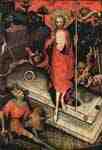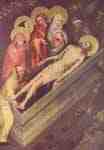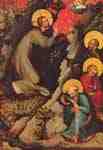Master Of The Trebon Altarpiece



Christ on the Mount of OlivesNursing Madonna
----
Fine Art Prints | Greeting Cards | Phone Cases | Lifestyle | Face Masks | Men's , Women' Apparel | Home Decor | jigsaw puzzles | Notebooks | Tapestries | ...
----
The Třeboň or Wittingau Altarpiece[1] is a now dismantled retable altarpiece commissioned for the Augustinian Canons church of St. Aegidius, Trebon. It was completed c 1380-1390 by the unidentified Bohemian painter known by the notname Master of the Třeboň Altarpiece or Master of Wittingau; one of the most important gothic artists of the international style.[2]
The altarpiece depicts events around the death and resurrection of Christ. It was influenced by the Devotio Moderna religious movement, emphasising contemplation, meditation and a focus on the inner life. The Třeboň Altarpiece is regarded for its intense use of colour and light, and its loose brushwork and elegant, rhythmical forms.[2]
At some point the work was broken up, with two surviving panels in the National Gallery, Prague, and a third in the Alsová Jihoceská Galeria, Hluboká nad Vltavou, Czech Republic. The extant panels are The Agony in the Garden, Entombment and the Resurrection. The reverse of the Agony shows languid, touching, "rosy-cheeked"[3] representations of Saints Catherine, Mary Magdalene and Margaret.
It is not known how many panels made up the original altarpiece, or how they were arranged. A total five is considered the most likely number, which would allow for four wings and a larger center piece.
Description
Master of the Eichhorn Madonna, Eichhorn Madonna, c 1350. Tempera paint on wood
It is thought the work consisted of five panels; a main (now lost) crucifixion and two pairs of wings, of which three survive. The outer panels, visible when the wings were folded, showed groupings of saints and apostles.[4]
Each extant panel is dominated by a single horizontal line in which Christ is centrally positioned.[5] Examination of the underdrawings show that the artist frequently deviated from his preliminary sketches, an indication of the looseness and freshness of his overall approach. The images are flat as they are completed before the advent of perspective. They are the more remarkable for the rich and precisely rendered small details, and use of glazes, given that they were completed before the development of oil painting some 30 years later. According to art historian Robert Suckale, "never before have weapons appeared sharper or shields more spiked." The painting is quintessentially Gothic[6] and does not evidence any Italian influence. Rather it can be within the tradition of Bohemian painting, or possibly Franco-Flemish art. Its innovative use of light may be traced to the techniques of the Master Theoderic, while the positioning of the knight below Christ in the Resurrection references the Christ child in the c 1350 Italian-Byzantium icon, the Eichhorn Madonna.[7]
Several of the figures wear heavily folded and sweeping robes or dresses, and the work is considered an important precedent to the Faltenstil (Fold style), popular in 15th Century Bohemian painting and sculpture.[6]
It is associated with the Devotio Moderna movement because it was commissioned at a time when the canon's church was undergoing growth and reform. It's high altar was consecrated in 1378; and the emperor, Wenceslaus IV of Bohemia, seems to have played a role in financing these moves. Certainly the Master of Wittingau was a leading painter in central Europe at the time, and the commissioning of a lavish polyptych would not have been inexpensive.[7]
Agony in the Garden
Reverse, showing saints Catherine, Mary Magdalene and Margaret
The panel is set in mountain terrain at night, with Chris kneeling and in profile. He addressed an angel in the upper right corner of the pictorial space. To his right side of are three sleeping apostles - saints: Saint James, John the Evangelist and St Peter. At the upper left is knight in armor. The colour scheme is composed of browns, intense reds (most vividly the sky and garments of St. John) and blues. The highly detailed rocky landscape contains stylised trees and smaller elements, including the many flowers and birds. The panel is overall harmonious and beautiful. It contains characteristic undulating lines,for example in the curves of St Peter's robes.[7]
Entombment
The Entombment panel contains a scene from the biblical entombment of Christ, as Christ's body is lowered into a stone sarcophagus. His body is covered with a transparent shroud, his head with a white blood stained scarf. His body is rigid, showing the effects of rigor mortis. To the left of the tomb are the mourners Joseph of Arimathea and Nicodemus, the Three Maries (Mary Magdalene, Mary of Clopas, and Mary, mother of Jesus). Above them is the dark, crouched figure St. John the Evangelist.
The mourners faces show strong emotions, but rather than despair, the mood is of grief and quite reflection. The attendants clothes are painted with highly saturated colors. St. John is dressed in scarlet, Mary in a blue dress, Mary Cleophas in olive and yellow. The lower part of the image is built from shades of gray and shows rock and small fragments of a landscape scene.[7]
Resurrection
Master of Vyšší Brod, Crucifixion, Bohemian, c 1350
Compared to the somewhat subdued nighttime atmosphere of the Agony in the Garden, the colours of the Entombment are vibrant, expressive and vivid, while the light is richly gradiated. The panel shows the risen Christ, having just "floated" out of his still sealed tomb. According to Suckale, "we are shown not the moment of resurrection, but the state of being resurrected. The painter presents the events as a true miracle."[7] Chris is dressed in a red robe which is formed in curves resembling those of flames. Its colour symbolises his shed blood; the wounds are still visible on his hands and side. He holds a long pole in his left hand, which topped with a banner and golden cross. Compared to the other figures in the exant panels, the resurrected Christ is grand, static and two dimensional, according to "rising from the sarcophagus like a timeless, incorporeal apparition".[4] Suckdale compares him to the crucified figures in the works of the Master of Vyšší Brod.[7]
Detail showing the knight at Christ's feet
In the left hand corner is a knight, seemingly just rumbled from his sleep,[4] looks up in awe at Christ. He wears a Coif and is clad in armor covered with a thin red tunic. He has a dagger attached to his belt, and holds a long sword and shield with a rounded shield boss.
References
Třeboň was named Wittingau in the 13th century, and the artist is known after both names. See Charles, Victoria. Gothic Art, Parkstone, 2014
Chilvers, 452
Gallagher et al, 135
Baragli, 348
Hourihane, 243
Baragli, 347
Suckale, 52
Sources
Baragli, Sandra. European Art of the Fourteenth Century. LA: J. Paul Getty Museum, 2007. ISBN 0-8923-6859-4
Chilvers, Ian. The Oxford Dictionary of Art. Oxford: Oxford University Press, 2004. ISBN 0-1986-0476-9
Gallagher, Mary-Ann; Gardner, Matthew. Kadri, Sadakat. Vienna, Prague, Budapest. Cadogan, 2007. ISBN 1-8601-1366-4
Hourihane, Colum. The Grove Encyclopedia of Medieval Art and Architecture, Volume 2. Oxford: Oxford University Press, 2012. ISBN 0-1953-9536-0
Suckale, Robert. Gothic. Cologne: Taschen. ISBN 3-8228-5292-9
Artist
A - B - C - D - E - F - G - H - I - J - K - L - M -
N - O - P - Q - R - S - T - U - V - W - X - Y - Z


